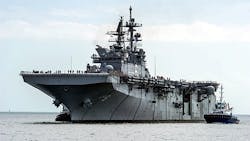Raytheon to build new Navy EASR shipboard radar for aircraft carriers and other large ships
Officials of the Naval Sea Systems Command in Washington are asking the Raytheon Integrated Defense Systems segment in Sudbury, Mass., to perform full-scale development of the Enterprise Air Surveillance Radar (EASR) to replace SPS-48 and SPS-49 rotating radars on large Navy ships.
Raytheon prevails on the EASR engineering and manufacturing development (EMD) contract over competitor Northrop Grumman Corp., which also was involved in EASR development. The new radar is for future ships and upgrades of ships now in the fleet.
Raytheon's EASR capitalizes on an existing radar modular assembly (RMA) architecture matured on the company's Air And Missile Defense Radar (AMDR) -- also called the SPY-6 radar -- for next-generation Navy Aegis combat systems for Arleigh Burke-class cruisers.
EASR is for different ship classes for ship self-defense, situational awareness, air traffic control, and weather monitoring.
The Radar Modular Assembly (RMA) affords EASR the scalability for a variety of ship sizes across diverse missions for advanced capabilities and affordable costs, company officials say.
Raytheon will receive $92.1 million up-front for the four-year contract to develop EASR in two configurations: a rotating phased array; and a three-face fixed-phased array, Navy officials say. The contract has options that could increase its value to $723.1 million.
The contract calls for Raytheon to build and test an EASR engineering-development model (EDM), beginning with design work leading to preliminary design review, and culminating with system acceptance of the EDM at the end of testing, Navy officials say.
Raytheon originally won a $6 million EASR study contract in 2014 from the Office of Naval Research in Arlington, Va., to find ways to evolve existing radar designs affordably to meet EASR requirements.
Related: Navy seeks to double funding for Advanced Above Water Sensors shipboard radar research
Plans call for installing EASR on the aircraft carrier USS John F. Kennedy -- the second ship of the Ford class -- to replace the dual-band radar (DBR), which has been discontinued because of its high cost. The yet-unnamed LHA 8 amphibious assault ship will be the Navy's first vessel to take EASR to sea.
On the EASR EMD contract Raytheon will do the work in Sudbury, Mass.; Fairfax, Va.; Andover, Mass.; Stafford Springs, Conn.; East Syracuse, N.Y.; High Ridge, Mo.; Flemington, N.J.; Indianapolis; Lawrenceville, Ga.; Eau Claire, Wis.; and Big Lake, Minn., and should be finished by February 2020.
For more information contact Raytheon Integrated Defense Systems online at www.raytheon.com, or Naval Sea Systems Command at www.navsea.navy.mil.
Learn more: search the Aerospace & Defense Buyer's Guide for companies, new products, press releases, and videos

